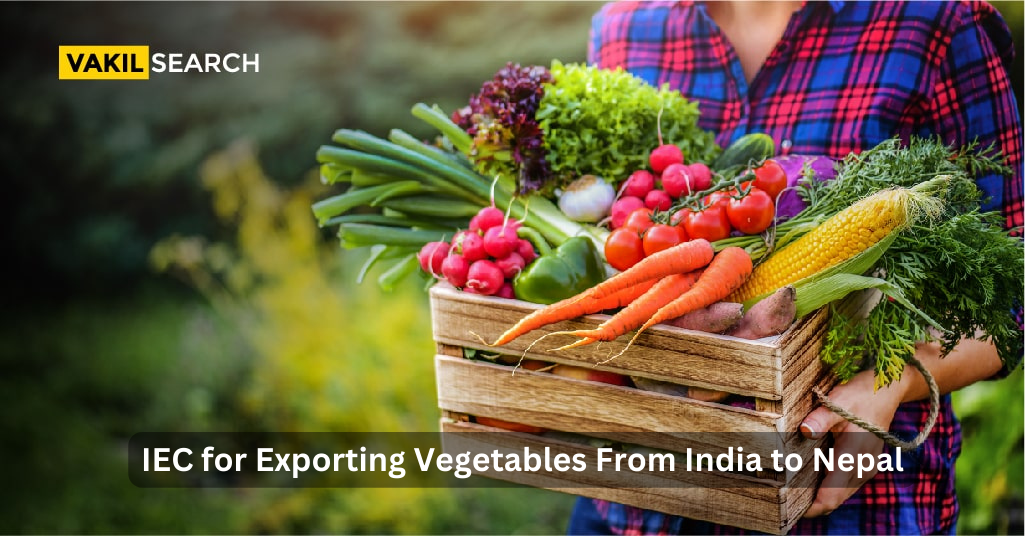India has been witnessing an increasing trend of traders opting to export vegetables to Nepal. There’s a lot of money to be made in the exciting world of foreign trade for those who are interested in exporting vegetables to agriculturally disadvantaged nations.
Overview:
The import-export license is required for exporting vegetables to Nepal from India. Additionally, the import-export code (IEC), a 10-digit identification number, is a mandatory requirement for every import/export business owner in India.
Moreover, it is not even necessary to show any import or export activity to obtain the IEC for Exporting Vegetables. Simply put, if you do not have an IEC for Exporting Vegetables, then you cannot export vegetables to Nepal.
What Is the Application Fee for an IEC in India?
- No fee for filing the Aayaat Niryaat Form
- No fee for filing the DGFT application form
- ₹1499 if you do not have your DSC Application or your Aadhaar card linked to your registered mobile number. A DSC is mandatory if you do not have your Aadhaar card linked to your registered mobile number
- A nominal professional fee of ₹500 is also directed by the government.
Benefits of IEC Registration
When you apply for an IEC in India, you can get certain benefits such as –
- IEC registration opens opportunities for traders to venture into the global marketplace
- IEC has lifetime validity. You do not need to renew it periodically
- Additionally, return filing is not mandatory for IEC registered traders. Moreover, you don’t even have to file your export/import transactions with the DGFT
- You can avail benefits under different government schemes such as exporting subsidy, Service Export from India Scheme (SEIS), Merchandise Export from India Scheme (MEIS), and other schemes as and when provided by the Department of Customs and Exporting Promotion
- Most importantly, the compliance burden on IEC registered businesses is relatively lesser than that for unregistered entities.
When Is IEC Code Not Required?
You are exempted from obtaining an IEC code if the following conditions are satisfied:
- As per the latest government circular, a trader does not require an IEC for Exporting Vegetables if he has a GST Registration. In such cases, the PAN of the trader will be considered as his IEC
- If you are exporting vegetables to Nepal for personal reasons not connected to any commercial activity
- If you are not dealing in the export of organisms, special chemicals, materials, types of equipment & technologies (as listed in the appendix – 3, schedule 2 of ITC)
- Additionally, if you are exporting vegetables or goods to Nepal in a single consignment whose value does not exceed ₹25,000.
How Can I Export Vegetables From India To Abroad?
To export vegetables from India to abroad, you can follow these general steps:
- Research and identify the target market: Conduct market research to identify countries that have a demand for the specific vegetables you intend to export. Consider factors such as import regulations, market size, competition, and potential profitability.
- Understand export regulations and requirements: Familiarize yourself with the export regulations and requirements of both India and the destination country. This includes obtaining the necessary licenses, permits, and certifications, and complying with phytosanitary and quality standards.
- Establish reliable suppliers and quality control: Ensure a consistent and reliable supply chain by partnering with reputable vegetable growers and suppliers. Implement stringent quality control measures to meet international standards and maintain the freshness and quality of the produce.
- Packaging and labeling: Packaging the vegetables in suitable containers that preserve freshness and prevent damage during transportation. Adhere to labeling requirements, including product information, nutritional facts, and country of origin.
- Logistics and transportation: Arrange for transportation and logistics services to export the vegetables safely and efficiently. Consider factors such as transportation mode (air, sea, or land), shipping schedules, and documentation (customs clearance, insurance, etc.).
- Marketing and distribution: Develop a marketing strategy to promote your exported vegetables in the target market. Identify potential buyers, distributors, or importers who can help you reach customers effectively.
- Documentation and compliance: Ensure all necessary export documentation is in order, including invoices, export declarations, certificates of origin, and shipping documents. Comply with customs and trade regulations to facilitate a smooth export process.
How to Apply for an IEC Online?
Here is the step-by-step guide to applying for an IEC code:
STEP 1
Visit the online portal of the DGFT. Click on the ‘Apply for IEC’ tab. https://www.dgft.gov.in/CP/
STEP 2
You will then be redirected to an online Import Export Code application form where you will need to fill up personal details such as name, mobile number, email ID, etc. Following this an OTP will be sent to your registered mobile number. Enter the OTP in the space provided and click the ‘Submit button.
STEP 3
On the next page, you will need to submit various details related to your business such as date of establishment, PAN, bank account details, etc.
STEP 4
In this step, you will need to pay the requisite Import Export Code application fee through an electronic fund transfer.
STEP 5
After successful payment, you will need to upload digital copies of the documents required.
STEP 6
In this next step, you will be asked to submit the completed Import Export Code application form. On successful submission, an Ecom reference number will appear on the screen.
STEP 7
Take a print of the completed form of the Import Export Code. As you will need to submit it to the appropriate DGFT office having jurisdiction over your operation.
STEP 8
On successful verification of your credentials, your Import Export Code will be issued within 3 to 7 days.
Ensure smooth and hassle-free Import Export Code procurement through Vakilsearch’s dedicated representatives who will collect, verify, cross-check, and file all the required documents on your behalf. Moreover, all efforts will be made to coordinate with the DGFT for expediting your IEC Application Process. Get in touch with us today!
Conclusion:
In conclusion, establishing an IEC for exporting vegetables is a crucial step towards facilitating and promoting international trade in the agricultural sector. This essay has examined the significance of IEC for Exporting Vegetables and its role in streamlining the export process for vegetable producers.
FAQs
Which Vegetable Is Highest Export In India?
India's highest exported vegetable varies over time, but commonly exported vegetables include onions, potatoes, tomatoes, okra (bhindi), and green chilies.
Is Exporting Vegetables Profitable?
Exporting vegetables can be profitable, depending on various factors such as demand, supply chain efficiency, pricing, quality control, and market conditions. It is essential to conduct thorough research and analysis before entering the export business to ensure profitability.
Which Country Imports Most Vegetables From India?
Some of the significant importers of vegetables from India include the United Arab Emirates, Bangladesh, Nepal, Malaysia, and the United States.
What Vegetables Make The Most Money?
Profitable vegetables often include high-value crops like pumpkin, winter squash, celery, brussle sprouts, bell peppers, and white asparagus. However, the profitability can vary across regions and market conditions.
What Are The Top 3 Crops Exported In India?
India's top three exported crops vary, but commonly exported crops include rice, basmati rice, wheat, cotton, sugar, spices, tea, and coffee.
Which Is The No 1 Vegetable Producing Country?
China is currently the largest vegetable-producing country in the world.
Read More:-










